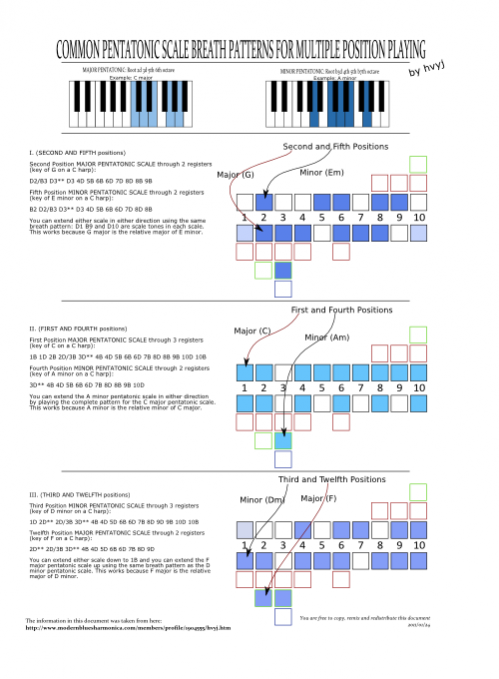Here's a chart that lays out pentatonic scales in six positions (click on the image to download the full-sized chart pdf):
A member of the Modern Blues Harmonica forum posted these breath patterns - His name is John Potts. I created the chart to give a more visual description of these breath patterns.
What does this all mean? How does it work?
First, what is the pentatonic scale?
 If you play the tonic, second, third, fifth and sixth notes of the major scale, you are playing the pentatonic scale. A lot of popular melodies are based on this scale and you will find that you can improvise around quite a lot of music with only these five notes.
If you play the tonic, second, third, fifth and sixth notes of the major scale, you are playing the pentatonic scale. A lot of popular melodies are based on this scale and you will find that you can improvise around quite a lot of music with only these five notes.
Try improvising along with a country song using the major pentatonic scale. Try doing the same with a song you hear on the radio. Quite often, the melody to a popular music song (mainstream, "top 40") is played with the major pentatonic scale. The major pentatonic scale is so simple and intuitive and yet so useful. It's a great place to start when learning to improvise.
 The major scale has a relative minor. Three semitones below the tonic of the major scale is the sixth. If you use that note as the tonic and play the same notes as in the major pentatonic scale, you are playing the minor pentatonic scale. For example, A minor is the relative minor of C major. When you play in A minor pentatonic, you are using the same notes and using the same scale as the major pentatonic scale in C but you are resolving (ending your phrases) on A. And what's most relevant to harmonica is that you are using the same breath pattern. So if you learn the breath pattern for the major pentatonic scale in C, you also know how to play in A minor!
The major scale has a relative minor. Three semitones below the tonic of the major scale is the sixth. If you use that note as the tonic and play the same notes as in the major pentatonic scale, you are playing the minor pentatonic scale. For example, A minor is the relative minor of C major. When you play in A minor pentatonic, you are using the same notes and using the same scale as the major pentatonic scale in C but you are resolving (ending your phrases) on A. And what's most relevant to harmonica is that you are using the same breath pattern. So if you learn the breath pattern for the major pentatonic scale in C, you also know how to play in A minor!
You only have to learn three breath patterns to access six different positions. Three major and three minor pentatonic scales are available without overblows or overdraws and a standard Richter-tuned diatonic harp!
Use this chart to learn the pattern for playing in the following keys on a C harp:
Play in G major (second position - 2 draw or 6 blow is tonic)
Play in E minor (fifth position - 2 blow or 5 blow is tonic)
Play in C major (first position - 1 blow or 4 blow is tonic)
Play in A minor (fourth position - 3 draw with whole step bend or 6 draw is tonic)
Play in F major (twelfth position - 2 draw with whole step bend or 5 draw is tonic)
Play in D minor (third position - 1 draw or 4 draw is tonic)
These scales are only the beginning. Try adding "blue" notes to the major pentatonic scale (flat fifth, flat seventh). Also, by adding just one note to the minor pentatonic scale, you play the blues scale in that position. Have fun playing in multiple positions!
